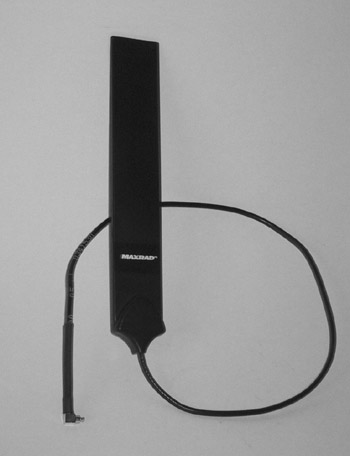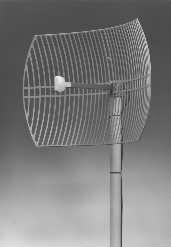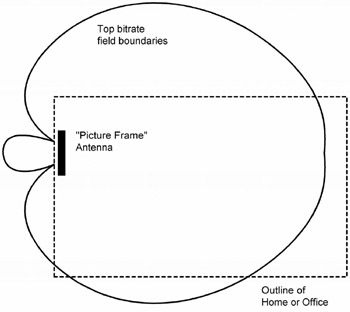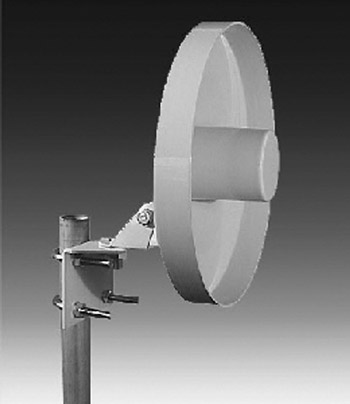dB, dBi, dBm: The Decibel Family
|
|
The Different Families of Antennas
Let me now take you on a quick tour of the Wi-Fi antenna kingdom. Most varieties of Wi-Fi antenna are of limited use for homes and small offices, but I'll mention the 'big guns' just the same, so you'll know what's out there.
One caution: In smaller homes and very small offices you may not need anything more than the small rubber omnidirectional antennas shipped with the access point. Test access point coverage before you spend your money on an external antenna! Don't provide gain where none is needed, especially where the home or office in question is very near others. Too much Wi-Fi coverage is as serious a problem as too little, albeit a very different kind of problem. If your Wi-Fi field reaches into adjacent floors or buildings, people on those floors or in those buildings can use packetsniffing tools to identify and possibly break into your network-and you may have no way to know what they're doing. The higher gain your antennas have, the farther away a drive-by hacker can be and still test your defenses. Why make things easier for them?
Omnidirectional Vertical Antennas
The simplest and commonest Wi-Fi antennas are omnidirectional antennas. The 4" long rubberized rod antennas that come with Wi-Fi access points are the best examples. They're called 'omnidirectional' because they radiate roughly equally in all directions. The operative word is 'roughly'-their radiation patterns are by no means spherical. They will, however, fill modest-sized houses (under 2,500 square feet) with a top-rate field, and if you find slow spots or dead spots in your house you can adjust simple access point antennas to some extent by rotating them and tilting them in various directions. ( Just like the old 'rabbit ears' TV antennas!)
Some access points have two such antennas, while many have only one. Why two? Two antennas allow something called diversity reception, which reduces the effects of certain kinds of reflection interference. I explained this in detail in Chapter 6.
Omnidirectional Vertical Gain Antennas
These are special-purpose outdoor antennas, used for either point-multipoint bridging or (less commonly) for servicing Wi-Fi clients in an open area like a university quad. In point-multipoint bridging, a centrally located omnidirectional vertical gain antenna provides a network link to networks in nearby buildings, each of which has a directional gain antenna pointed at the omnidirectional vertical. They are generally fiberglass tubes from 12" to 40" long and under an inch in diameter. They cost from $100 to $400.
Omnidirectional vertical gain antennas can have as much as 12 dbi gain. One problem with omnidirectional antennas with this much gain is that their vertical beam width is quite narrow (as little as 7 degrees for a unit like Pacific Wireless' 12 dbi omni) and if the antenna is mounted too high, the bulk of its radiation never reaches the ground! This may, of course, be a good thing, if you want to minimize access to rooftop point-to-point data links by people on the ground.
I use a 5 dBi magnetic-mount omnidirectional vertical gain antenna for wardriving. For more on this antenna and why wardriving requires that sort of antenna, see Chapter 18.
PC Card Integrated 'Bulge' Antennas
By all measure the worst Wi-Fi antennas are the ones baked into the PCMCIA PC card client adapters that you plug into your laptop. These 'integrated' antennas are inside the plastic bulge that extends beyond the end of the card. They are miraculously small, but they are also oriented horizontally, and most Wi-Fi antennas are vertical. Radio signals have an orientation aspect called polarization, and when a vertical antenna emits a radio field, it is picked up most effectively by another vertical antenna. It is picked up least effectively by a horizontal antenna, and this accounts for most of the shortcomings of integrated PC card antennas.
Although integrated antennas work acceptably in most cases, on the fringe of your Wi-Fi field they may come up short. This is why I always recommend buying a Wi-Fi PCMCIA client adapter with an external antenna jack, like the Orinoco Gold card and the Cisco Aironet 350 client card. You can buy simple external antennas (like blade antennas, which I'll describe next) to extend the reach of PC card integrated antennas. In Chapter 15 I describe home-made antennas that can be used for the same purpose.
Blade Antennas
A blade antenna is a very simple, small omnidirectional antenna built into a thin, flat (hence the name) piece of plastic. Blade antennas are often literally glued or velcroed to walls (sometimes cubicle walls) to finesse a Wi-Fi dead spot, where the signal from an access point won't otherwise reach at full speed or perhaps at all. Figure 8.3 shows a typical blade antenna from Maxrad. This model costs about $50, and has a short length of low-loss coaxial cable terminated in an RMC connector, for use with an Orinoco PCMCIA card. They can be obtained with most of the commonly used coaxial connectors.

Figure 8.3: A Blade Antenna from Maxrad. (Photo courtesy of Maxrad.)
A blade antenna rarely delivers any significant gain (except in comparison to a PC card's miserable 'bulge' antenna) and is used mostly to 'catch' signal by allowing the antenna to be a short distance from the computer. Sometimes mounting a blade antenna just two feet above a cubicle desktop will allow a computer to connect to the network where it otherwise wouldn't.
Breezecom makes an $70 blade antenna mounted on a little desk stand so you can park it on a flat surface rather than Velcro it to the wall. The Breezecom unit is bulky and less versatile than an unmounted blade. If you want the Maxrad to stand up on your desk, make a stand from a candle holder and some modeling clay, or glue a clothespin to some sort of nonmetallic base. I've used the (admittedly ugly) lashup shown in Figure 8.4 with good results finessing a couple of weak spots at work. It's nothing more than a clothespin stuck into the center hole of an octal tube socket mounted on a little masonite slab.

Figure 8.4: A Blade Antenna on a Home-Made Desk Stand. (Photo courtesy of Maxrad.)
I've also used a blade antenna to wardrive from the back seat of a taxi, by hanging it from a suction cup stuck to the cab's window. It's handy to have one in the drawer for such special applications.
Ceiling Blister Omnidirectional Antennas
Antennas are almost universally considered ugly (unless you're a real tech freak like me) and there are products designed specifically to make them less obtrusive for indoor environments. Ceiling blister antennas are designed for use in the ceilings of large office spaces (above cube farms, for example) to provide omnidirectional coverage without looking too much like antennas. Gain is not the point here, and ceiling blister antennas usually offer only about 3 dbi of gain.
Blister antennas for Wi-Fi use are about the size and shape of a large smoke detector: flattish and round, between 5" and 8" in diameter and 3" to 4" thick. Most are shipped with about a foot of pigtail, terminated by an N female connector. The idea is to mount them into a wallboard or dropped ceiling and place access points immediately above them, with Category 5 cable connecting the access point into the network. In my experience, ceiling blister antennas are overkill for residences, unless you're outfitting something in the 10,000 square foot range. See Figure 8.5 for a typical blister antenna from Pacific Wireless.

Figure 8.5: A Ceiling Blister Antenna. (Photo courtesy of Pacific Wireless, Inc.)
If Wi-Fi connectivity really catches on in corporate environments (it's still a little exotic), we're likely to see low-cost ceiling blister antenna assemblies that actually contain access points, making it even simpler to deploy an ESS (Extended Service Set) wireless network.
Waveguide Antennas
At very short wavelengths (like those of Wi-Fi signals) it becomes possible to pass signals literally through a metal pipe. The laws of physics tell us that, introduced into a round or rectangular pipe of the proper dimensions, radio waves will line up like soldiers and march in formation through the pipe with minimal loss, even if the pipe bends or turns right-angle corners. Such a pipe, of a size calculated according to the correct formula, is called a waveguide. Waveguides are used extensively in radar installations to conduct high-power radar signals between transmitters and antennas.
A short, straight section of waveguide can be used as an antenna, if one end is closed and the other left open. Such waveguide antennas are fairly light and compact, and can be made very cheaply. Short waveguide antennas have moderate gain (about 10 to 12 dBi) and are quite efficient if made correctly. Figure 8.6 shows the Super Cantenna, a commercial waveguide antenna that sells for about $20. (See www.cantenna.com.)

Figure 8.6: The Super Cantenna Waveguide Antenna. (Photo courtesy of Cantenna.)
If you're not fussy about appearances and have some skill with hand tools, you can make your own waveguide antennas from coffee cans, food cans, tennis ball cans, or even 'Tetra Brik' foil-cardboard soup and milk boxes. I lay out the math and provide detailed step-by-step instructions on how to build your own in Chapter 15.
Parabolic Grid Antennas
For point-to-point network bridging work across distances I favor parabolic grid antennas over their chief competition, Yagi antennas. Both are extremely focused gain antennas, but Yagis are long and skinny and simply more difficult to mount and adjust. I've had excellent results with the parabolic grids from Pacific Wireless. Their top-of-the-line 24 dbi model is shown in Figure 8.7. It sells for about $75 new. Smaller models down to 15 dBi gain can be had for as little as $50.

Figure 8.7: A 24: dBi Parabolic Grid Antenna. (Photo courtesy of Pacific Wireless, Inc.)
Parabolic grid antennas are light and compact and the wind blows right through them, which isn't the case for some of the used and surplus satellite TV parabolic dish antennas that some people have pressed into Wi-Fi service for very high gain.
Picture Frame Antennas
'Picture frame' is my coinage here; these antennas have a lot of names, including panel antennas and directional patch antennas. They are generally square or rectangular and may be hung on or bolted to a wall. They are directional in that they are designed to radiate forward and to their sides, but not behind them. The idea is to 'fill the room' with signal as much as possible, but not send signal backwards through the walls they're mounted on. Audio people will understand when I say that the antenna has a 'cardioid' radiation pattern, as shown in Figure 8.8. The little 'tail' sticking out straight behind the antenna is not very strong and will be attenuated by the wall.

Figure 8.8: A Picture Frame Antenna's Radiation Pattern.
The radiation pattern shown in Figure 8.8 is the 'free space' pattern, and I've superimposed it on the rough outline of a typical home or small office, as you would do to evaluate an antenna of this type. The actual shape of the pattern will depend heavily on the structure and what it's made of, but you can assume that the top bitrate field boundaries will not extend quite so far outside of the structure. Note that the radiation pattern as shown isn't an all-or-nothing proposition. What I show is roughly the boundaries of where the maximum bit rate can be achieved; outside that boundary the bitrate will drop to an intermediate level. There may be 'slow spots' or dead spots within the boundaries, depending on metal obstructions and how the structure is built. You won't know until you walk around with a laptop and test the field!
The antenna I've used in installing wireless networks for some of my clients (the 10 dBi gain Pacific Wireless PAWIN24-10) is 8.5" x 7.5" x 1 3/4" ' thick, and costs about $50. (See Figure 8.9.) It's excellent for small and medium-sized offices or larger single-level homes, where the access point is at one end of the structure to be covered. It's not suitable for multi-story homes, because it has a fairly narrow radiation pattern in the vertical dimension. (Look back at Figure 8.2, which is a side view of its radiation pattern.) In my own house, my wife was unable to connect from her office almost precisely below and a little behind the antenna, and the signal was marginal in our first-floor living room, irrespective of the 10 dbi gain directed square at (but above) the living room.

Figure 8.9: The Pacific Wireless PAWIN24-10: Antenna. (Photo courtesy of Pacific Wireless, Inc.)
Sector Antennas
Sector antennas are large, heavy outdoor gain antennas, designed to confine their radiation to a specific fan-shaped pattern of a specified angular width. This pattern is a sector of a 360-degree omnidirectional radiation pattern, hence the name. Sector antennas are used in virtually all cell phone towers, and you've probably seen them without knowing what they were. Sector antennas are sometimes used by business or university campus Wi-Fi systems to cover wide areas. They're quite expensive (generally over a thousand dollars) and are not of much interest to residential and small office wireless users.
Backfire Antennas
A backfire antenna is a compact gain antenna for outdoor use. A typical backfire antenna for Wi-Fi frequencies is a little under 11" in diameter and looks like a pie plate with a can in the middle of it. Pacific Wireless makes a $50 backfire with 14 dbi gain. For outdoor gain antennas I prefer parabolic grid antennas because they present a lower profile to the wind. Figure 8.10 shows a Pacific Wireless backfire antenna, the PAWES24-14.

Figure 8.10: A Backfire Antenna. (Photo courtesy of Pacific Wireless, Inc.)
Yagi Antennas
The canonical rooftop TV antenna is a species of Yagi antenna. The Yagi antenna's characteristic 'fishbone' structure is key: A long spine (called the boom) to which perpendicular elements are attached in a row at precisely calculated intervals.
The longer the Yagi antenna, the more focused its radiation is in a single line. Yagi antennas can be made quite long (especially at microwave frequencies, where the elements are only a few centimeters wide) and have tremendous gain, generally from 12-20 dbi. Their extremely narrow radiation patterns make them suitable only for point-to-point work, bridging networks in different buildings, and more rarely allowing an outlier client to connect to a distant access point.
Because Yagi antenna elements at Wi-Fi microwave frequencies are so short, the 'fishbone' elements can be disks instead of rods, and many Wi-Fi Yagi antennas look like washers spaced out along a length of metal rod. (That's often precisely what they are.) The structure of commercial Yagi antennas is often hidden inside a length of white PVC pipe, so that you don't necessarily see the disks or rods that the antenna is made of.
You'll see a lot of articles on the Web by people who have built their own Yagi antennas for Wi-Fi use, often by stringing fender washers on a length of threaded rod, with carefully cut lengths of metal tubing acting as spacers. This can be done, but my own experiments show that it's not nearly as simple as certain experimenters make it sound, and I won't provide instructions in this book. It's way easier to make a waveguide antenna from a coffee can or a Tetra Brik soup box. I explain how in detail in Chapter 15. If you're not a machinist and really need the gain of an extralong Yagi, I recommend commercial parabolic grid antennas from vendors like Pacific Wireless.
A Special Case: The Pringle's Can Antenna
As best I can tell, the well-known (nay, legendary) Pringle's can Wi-Fi antenna was first published on the Web by Andrew Clapp, and later made famous by the much more visible Rob Flickenger of O'Reilly Books. Rob calls the antenna a 'shotgun Yagi,' and technically that's what it is, and more or less looks like: A long tubular thing made from PVC pipe and a Pringle's can, with a very narrow directional pattern and 12 dbi gain. Note well that this is not a waveguide antenna, as some claim it to be. The silvery material inside of the can is not sufficiently metallic (if indeed it's conductive at all; my tests show that it is not) to make a waveguide. The metallic can bottom does act as a reflector, but the can itself is useful for insulation and structure only.
Rob's article on the antenna is very good, and I suggest you read it carefully: http://www.oreillynet.com/cs/weblog/view/wlg/448
The antenna works-if you do it Rob's way. He adds a short Yagi director array using washers, and that's where the antenna's gain comes from. However, a lot of people speak of using the Pringle's can as though it were a metallic cylinder, and thus a waveguide. It's not, and what gain happens under those circumstances is probably due to the metal bottom of the can acting as a very simple reflector.
On the balance, if you really want a gain antenna, you can do much better with other designs. One of my primary objections to a high-gain (and thus highly directional) antenna made of cardboard is that directional antennas are most useful mounted permanently for point-to-point work, such as linking wired networks in two close but unconnected buildings. This means mounted outside -in the rain and the snow, which would make quick mush of any cardboard tube.
In other words, the Pringle's antenna is more valuable in the Wi-Fi community as an emblem of the marvelous gonzo innovative style that wireless experimenters have brought to the Wi-Fi field. You can make an even better antenna out of spaghetti sauce, juice, or coffee cans-see Chapter 15-that will stand up to the weather, but that's just not as, well, nuts.
|
|
EAN: 2147483647
Pages: 181